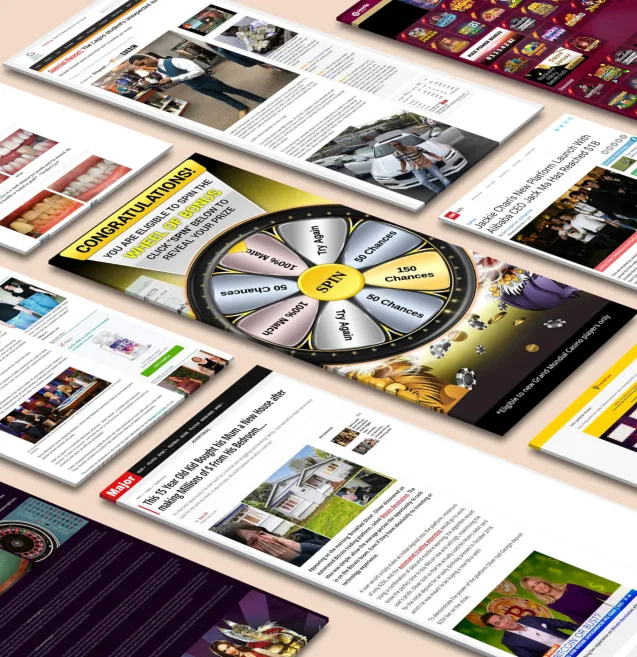
Our spy tools monitor millions of native ads from over 60+ countries and thousands of publishers.
Get StartedNative advertising has transformed digital marketing by seamlessly integrating promotional content into the natural flow of user experiences. These paid advertisements match the form and function of the platform they appear on, creating a non-disruptive user experience that traditional advertising methods struggle to achieve.
The digital advertising landscape has seen a significant increase in native advertising adoption. Brands are investing heavily in this format because it helps overcome "banner blindness" and delivers higher engagement rates compared to conventional display ads.
This article explores two critical aspects that shape the effectiveness of native advertising:
Research shows that these elements have a significant impact on how users recognize and evaluate native advertisements. The positioning of disclosure statements and the words chosen to signal sponsored content can make the difference between transparent communication and potential consumer confusion.
Trust and transparency are fundamental principles in the native advertising ecosystem. As advertisers create more sophisticated native content, it becomes essential to maintain clear disclosure practices in order to:
Understanding these dynamics helps marketers create native advertising campaigns that balance effectiveness with ethical considerations, leading to sustainable advertising practices in our digital age.
Native advertising has come a long way since its inception. Let's take a closer look at how it has evolved over the years.
The roots of native advertising can be traced back to the early 20th century when advertorials made their debut in print media. These paid articles were cleverly crafted to blend in with the editorial style of newspapers and magazines, marking the beginning of the fusion between promotional content and traditional media formats.
In the 1950s and 1960s, infomercials emerged as another pioneering form of native advertising. Unlike traditional commercials, these long-form television ads took an educational approach while promoting products, laying the groundwork for future content marketing strategies.
With the advent of the digital age, native advertising underwent a significant transformation:
The native advertising market has witnessed remarkable growth over the years:
This exponential growth signifies a shift in advertising preferences, with native ads becoming a primary revenue source for digital publishers. Companies like BuzzFeed have built entire business models around native content, with 75% of their revenue stemming from native advertising campaigns.
Today, modern native advertising encompasses diverse formats:
The rise of mobile devices has particularly influenced the development of native advertising. Mobile-first platforms like Instagram and TikTok have created new opportunities for seamless ad integration, with native ads accounting for 63% of all mobile display advertising spending.
Publishers have also adapted their strategies to accommodate this evolution. Successful examples include The New York Times' T Brand Studio and The Atlantic's Re:think - both representing in-house content studios dedicated to creating sophisticated native advertising campaigns that maintain editorial quality while serving commercial interests.
This transformation from simple advertorials to complex digital campaigns reflects broader changes in consumer behavior and technological capabilities. The industry continues to adapt, with artificial intelligence and machine learning enabling more sophisticated targeting and content personalization in native advertising campaigns.
The Federal Trade Commission (FTC) maintains strict guidelines for native advertising disclosure, emphasizing transparency in digital marketing practices. These guidelines require advertisers to make disclosures clear and prominent to prevent consumer deception.
A landmark case highlighting the importance of proper disclosure involved Lord & Taylor in 2016. The retailer faced FTC sanctions for failing to disclose paid Instagram posts and native article placements. The company orchestrated a campaign where 50 Instagram influencers wore the same dress without revealing their compensated partnerships, reaching 11.4 million users with deceptive content.
Research by the Native Advertising Institute reveals significant disparities in consumer recognition rates:
The study identified common labeling practices that create confusion:
The FTC has taken action against several major brands, including Warner Bros. and Microsoft, for inadequate disclosure practices. Warner Bros. paid influencers to post positive game reviews without proper disclosure, while Microsoft faced scrutiny for compensating YouTubers without transparent labeling.
Recent eye-tracking studies demonstrate that consumers spend 52% less time viewing disclosure labels compared to actual content. This behavior pattern suggests that current labeling practices might not effectively capture user attention or communicate advertising intent.
The Interactive Advertising Bureau (IAB) recommends standardized disclosure language across platforms:
"Paid Post," "Sponsored Content," or "Advertisement" should appear prominently at the top of native ad content, using distinct typography and color schemes.
These guidelines aim to create consistency in native advertising disclosure practices while maintaining advertising effectiveness.
Research shows that where disclosure labels are placed can greatly affect how users understand and recognize native ads. A recent study published in the Journal of Interactive Advertising reveals that the position of the disclosure label can lead to different levels of ad recognition among consumers.
The way disclosure labels are positioned creates different patterns in how users behave and interpret content. When disclosures are placed at the top, users can immediately recognize it as an ad and approach the content with the right expectations. This placement follows natural reading patterns and helps users make informed decisions about whether to engage with the content or not.
Search results pages (SRP) pose unique challenges for where to place disclosures. Studies show that users often overlook disclosures placed at the bottom of search results, which can lead to misunderstandings about sponsored content being seen as organic search results.
The effectiveness of disclosure position varies across different platforms and devices. Mobile users have distinct behavior patterns, with top-positioned disclosures proving most effective for recognizing ads. Desktop users show more flexibility in processing disclosures that are positioned differently.
Research from the "Going Native" study highlights that where disclosures are placed affects not only recognition but also how users evaluate the content. Clear, top-positioned disclosures lead to:
These findings underline the importance of carefully considering where to place disclosures in native advertising strategies. The position of disclosure labels influences both how quickly advertising content is recognized and how brands are perceived by their audience over time.
The language used in native advertising disclosures plays a crucial role in consumer recognition and understanding. Research shows significant variations in how different terminology affects user perception and trust.
Studies reveal that explicit terms like "Advertisement" and "Sponsored" generate higher recognition rates among consumers. A Nielsen study found that 79% of users correctly identified content as advertising when labeled "Advertisement," compared to only 48% when labeled "Presented by."
The choice of disclosure language creates varying levels of transparency:
Research by the University of Georgia demonstrates that users perceive brands using clear disclosure language as more trustworthy, despite initial resistance to engaging with advertised content.
Different platforms require unique approaches to disclosure terminology:
Social Media:
News Sites:
The terminology effectiveness varies by platform, with social media users showing higher recognition rates for standardized disclosure language compared to news site visitors.
Language choice impacts different demographics uniquely:
A study by the Content Marketing Institute reveals that 62% of consumers trust native ads more when the disclosure language aligns with their cultural expectations and platform habits.
Recent studies show that many consumers are confused about native advertising. A research study from Stanford University found that 82% of middle school students couldn't tell the difference between sponsored content and real news articles on a website.
Another research study by the Content Marketing Institute revealed some important findings:
Several factors contribute to how consumers perceive native ads:
Native ads are designed to look like regular editorial content, making it difficult for readers to distinguish between the two. While this approach may be effective in capturing attention, it raises ethical concerns about manipulating consumers.
When consumers find out that they have unknowingly read sponsored content, it affects their perception of brands, credibility of publishers, and likelihood to engage with such content in the future.
Research by Nielsen Norman Group shows that different age groups have varying abilities to recognize native ads. Younger generations tend to have lower recognition rates compared to older ones.
Consumer confusion varies across different platforms where native advertising is displayed. Social media platforms seem to have the highest confusion rate, followed by news websites, blogs, and e-commerce sites.
As consumers become more skeptical, the integrity of native advertising is being questioned. A survey conducted by MediaPost found that 76% of readers feel misled when they discover content is sponsored after spending time reading it.
Factors that influence consumer trust in sponsored content include:
These findings highlight the complex relationship between the effectiveness of native advertising and consumer trust. It also emphasizes the need for clearer disclosure practices across digital platforms.
The ethical landscape of native advertising presents complex challenges for marketers and publishers. Industry watchdogs raise concerns about the blurred lines between editorial content and paid promotions, with prominent voices like John Oliver highlighting these issues in his viral segment on Last Week Tonight. Oliver's critique sparked widespread discussion about the responsibility of publishers to maintain editorial integrity while pursuing profitable advertising strategies.
Key Ethical Challenges in Native Advertising:
The rise of mobile platforms has transformed native advertising practices. Mobile-first content consumption patterns demand seamless integration of sponsored content, pushing advertisers to develop increasingly sophisticated approaches. Research indicates that 70% of users prefer to learn about products through content rather than traditional advertising methods.
Emerging Trends and Future Directions:
Ad-blocking technology continues to shape native advertising evolution. Publishers implement new strategies to deliver value while respecting user preferences. This includes developing high-quality sponsored content that provides genuine utility to readers.
The demand for transparency drives innovation in native advertising disclosure methods. Publishers experiment with interactive elements and clear visual cues to distinguish sponsored content. These developments reflect a growing understanding that ethical practices build sustainable relationships with audiences.
Industry leaders predict a shift toward "value-first" native advertising. This approach prioritizes creating meaningful content that serves user needs while maintaining clear sponsorship identification. The strategy aims to balance commercial interests with ethical considerations.
The integration of augmented reality and virtual reality presents new opportunities and challenges for native advertising disclosure. These immersive formats require innovative approaches to maintain transparency while delivering engaging sponsored experiences.
Legal frameworks continue to evolve alongside technological advancements. Regulatory bodies worldwide develop new guidelines to address emerging native advertising formats, emphasizing the need for clear disclosure across all platforms and mediums.
Native advertising is at a crucial point. Research shows that where and how disclosures are presented can greatly affect whether consumers notice them and trust them. Advertisers and publishers must carefully think about how to balance effective marketing with ethical transparency.
Key insights from the research reveal:
The future success of native advertising depends on the industry's commitment to ethical practices. Advertisers must prioritize clear disclosures and honest communication to maintain consumer trust. This approach not only satisfies regulatory requirements but creates sustainable value for brands and audiences.
For comprehensive tools and strategies to improve your native advertising, explore Anstrex Native, which can help refine your campaigns and align them with best practices.
Your role as an advertiser carries significant responsibility. Consider these action steps:
The way forward requires a shared commitment to being open and honest. By adopting ethical native advertising practices, you can connect with audiences in a meaningful way while also protecting the reputation of digital marketing. Choosing to prioritize clarity and honesty in native advertising isn't just the right thing to do—it's also good for business.
Receive top converting landing pages in your inbox every week from us.
Must Read
As third-party cookies fade away, contextual targeting is making a powerful comeback. Learn how to leverage native ads that align with user intent and content relevance to maintain high engagement and conversions. Discover modern tools and tactics that make cookie-free targeting both precise and scalable. Ideal for advertisers seeking privacy-friendly ways to drive performance in 2025 and beyond.
Liam O’Connor
7 minDec 9, 2025
Recently Updated
Native ads can make or break your holiday marketing success. Explore how to evaluate your recent campaigns and identify what worked—or what fell short—with native advertising. Learn key optimization tactics to boost engagement, strengthen audience trust, and increase conversions in future promotions. Ideal for marketers aiming to refine their ad strategies after the holiday rush.
Elena Morales
7 minDec 1, 2025
Quick Read
After Black Friday, shoppers crave more than just deals—they want connection and meaning. Explore how creative storytelling can turn post-sale campaigns into powerful conversion drivers. Learn how to craft narratives that build trust, strengthen brand loyalty, and inspire action beyond discounts. Perfect for marketers aiming to keep engagement high long after the sales frenzy ends.
Marcus Chen
7 minNov 29, 2025




